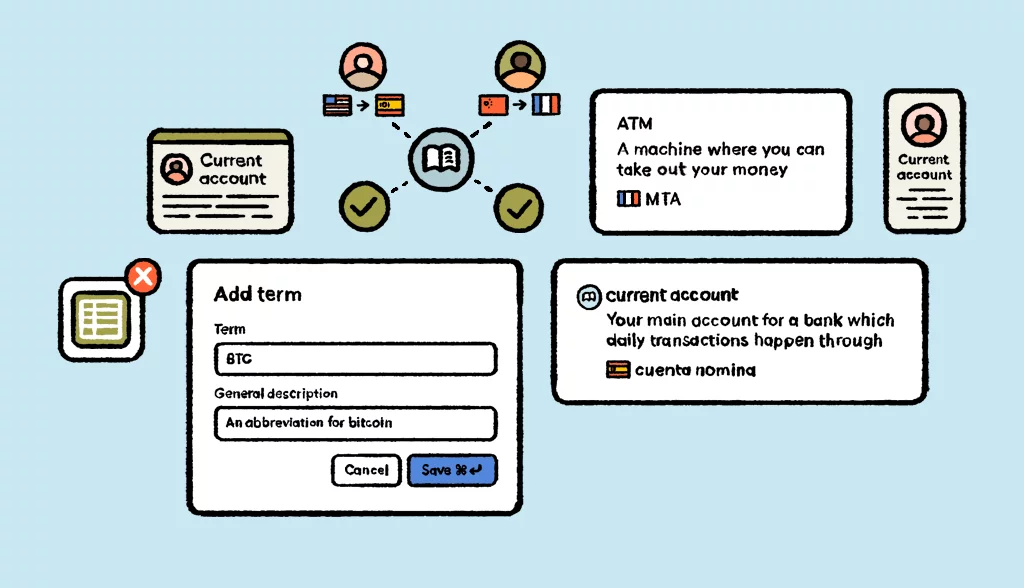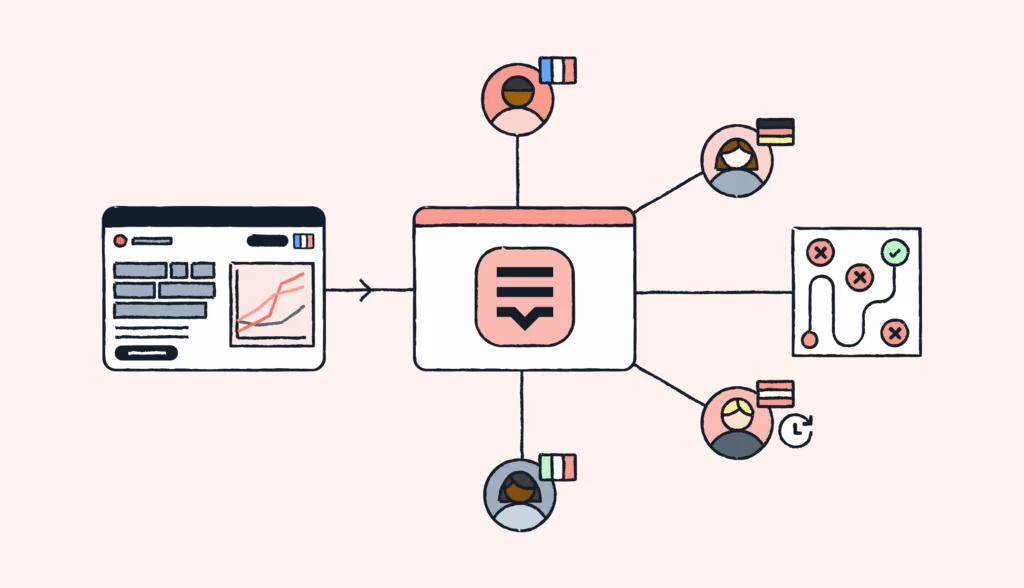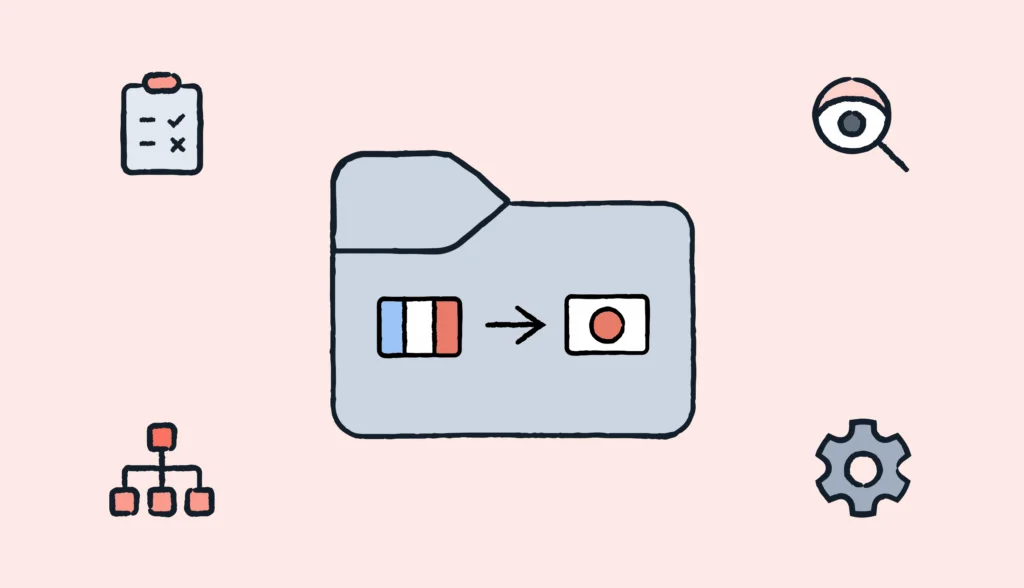Each industry has its own jargon and terminology. And each company has brand-specific phrases, non-translatable terms, and abbreviations. When you work with translators who are from outside your field, a glossary is a key component of the language assets you will need to build to keep your translations consistent—a fundamental part of effective localization management.
In this short post, we’ll teach you how to set up and maintain a glossary to help your linguists work faster while ensuring consistency.
What is a glossary?
A glossary is a list of commonly used terms, their definitions, and their translations. It can be based on just one project, a brand’s own terminology, or even an entire industry. Also known as a termbase, a glossary is an incredibly valuable resource and tool to enhance any localization project. A well-maintained localization glossary ensures consistency across all translated content, helps onboard new translators more quickly, and reduces the risk of miscommunication. As a core component of localization management, the localization glossary plays a critical role in maintaining brand voice and accuracy across languages.
So, why is having a glossary so important?
A well-crafted glossary makes any localization project easier for everyone involved. As well as having terms readily approved by your team, it reduces back and forth between team members.
It means a translator won’t have to translate one common word or phrase again and again, and they can ensure consistency through the project.
Typically, all the terms used for a localization project or product would be stored in one glossary. The glossary can then be used across multiple projects and shared between translators.
When a company starts localizing for the first time, they usually store their glossary in a spreadsheet. However, they are then missing out on the many collaborative features that a localization tool can offer, such as the connection with the translation editor. When you are translating in the editor and a term from your glossary comes up, the glossary term and translation will also show in the translation editor.
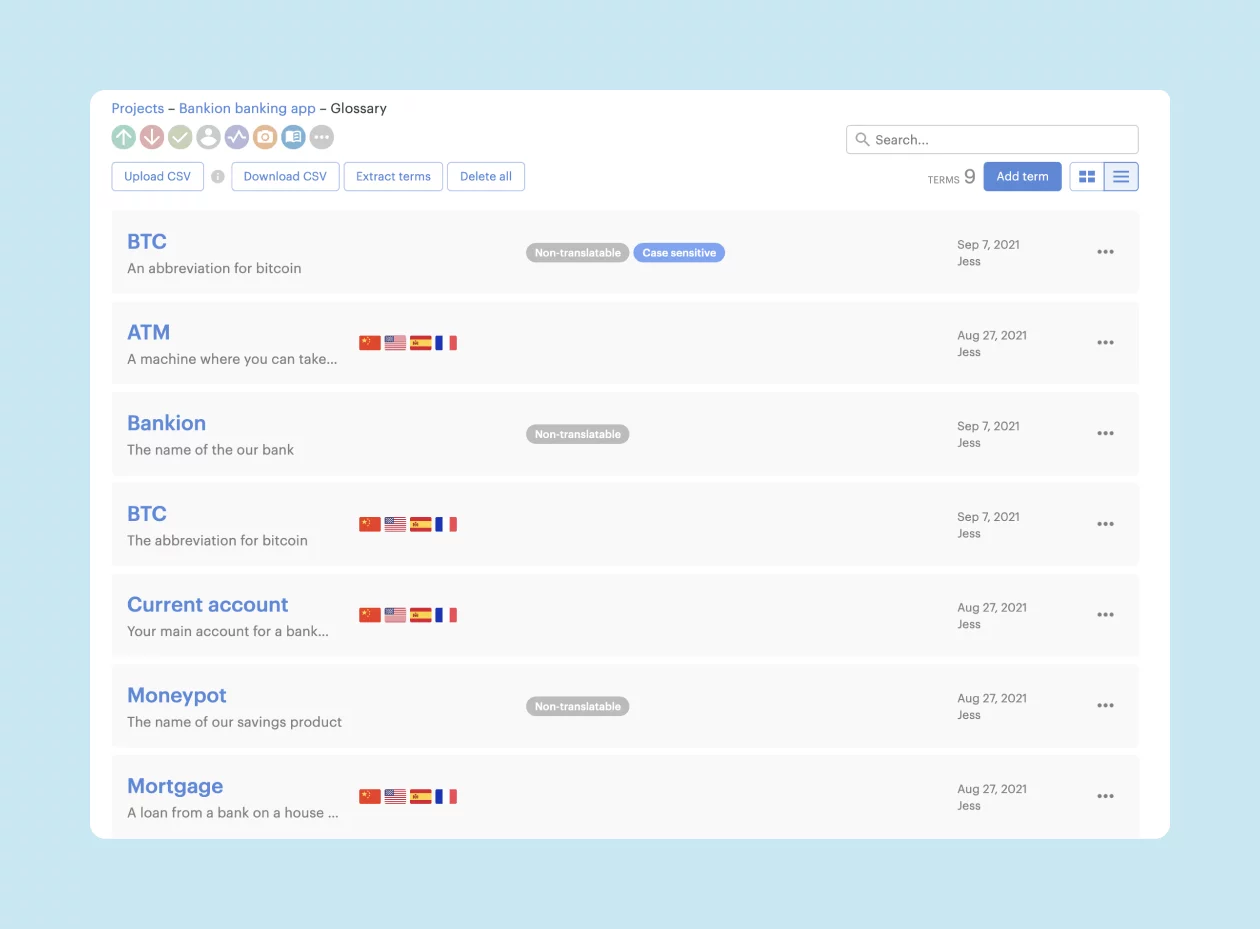
What kinds of words belong in a glossary?
To start, let’s look at the common types of words or phrases added to a glossary:
- Brand or company-specific phrases
- Industry-specific terms or phrases
- Commonly used terms
- Forbidden terms
- Non-translatables
- Abbreviations.
Let’s imagine we’re localizing a new digital banking app. This app would use a lot of banking and industry-specific jargon. It also uses non-translatable names for app features, which the team wants to keep the same across different languages. In this example, we see the term “current account”. In Spain, the country team wants to localize this as “cuenta nómina,” (a common bank account type in Spain) even though the machine translation is suggesting “cuenta corriente.” So here, the glossary suggestion is very important as it provides additional context.
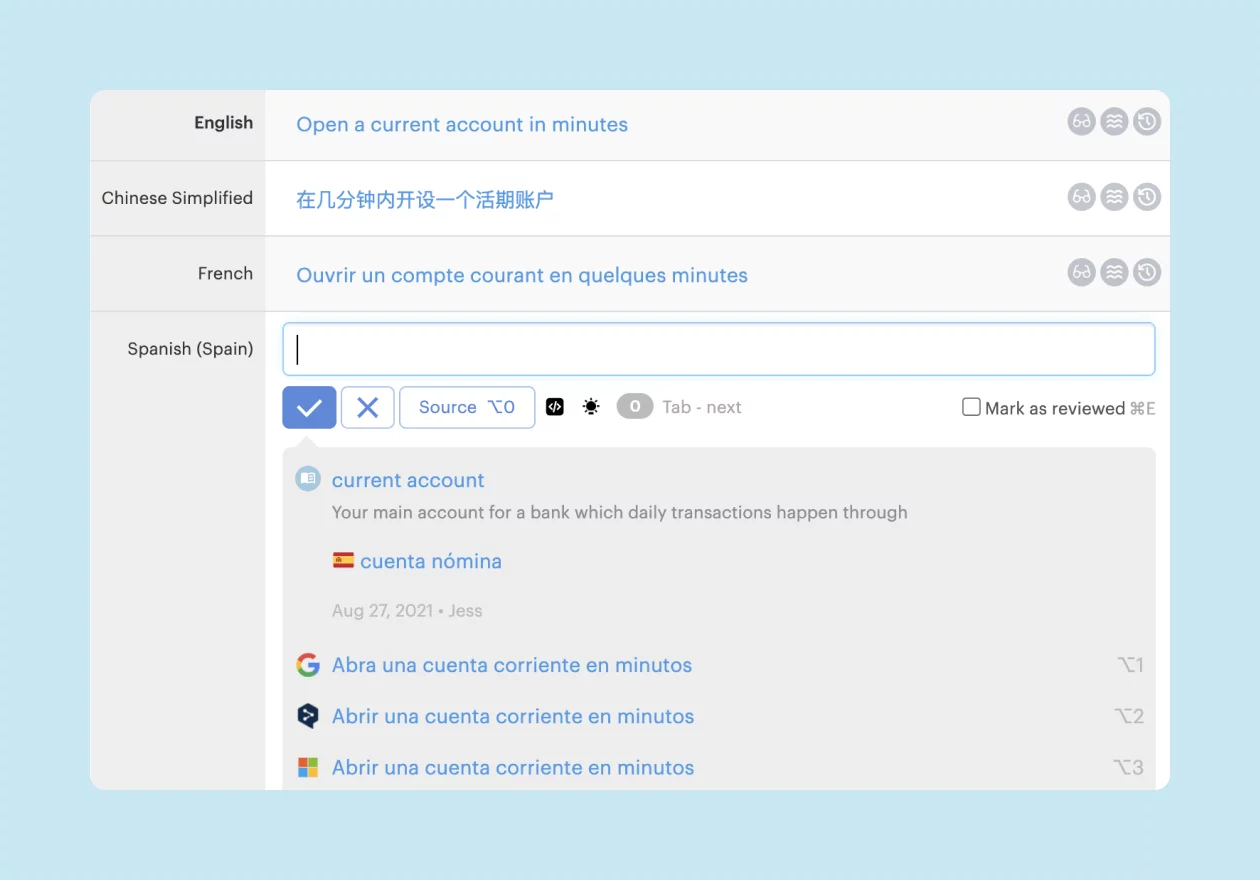
The benefits of using a glossary
So, why would you need to use a glossary? Well, there are a few good reasons.
More accurate translations
Sometimes, a word may have several meanings or translations, meaning that a translator will have to consider those options each time they translate that word. A glossary provides an already-approved term, a translation, and an explanation to ensure correct usage, reducing ambiguity and helping prevent issues that could surface during localization testing.
Consistency across your project(s)
A glossary means you use the same translation for a term throughout one or several projects. This helps maintain a high-quality and consistent translation across everything you are translating, which could be multiple web pages or app screens. It therefore ensures anything you add to the translation memory that is repeated is of high quality, supporting effective localization quality assurance throughout the process
What’s more, if you are translating across locales or with multiple translators, a glossary allows a standard term to be used without translators introducing multiple definitions in error.
Save time
As a translator, using a glossary means you won’t waste time translating the same term over and over. This doesn’t just improve your productivity, it also makes the quality check and review process more efficient too.
In summary, using a glossary makes a translator more efficient. It means they use consistent terminology throughout a project and don’t have to spend time pondering over difficult translations. This increased efficiency and consistency directly contribute to a higher localization ROI by reducing rework, improving quality, and speeding up time-to-market.
Better SEO
You might have heard of SEO, or search engine optimization, which is the process of ensuring your page is visible and easily found on search engines like Google. For marketing managers or those localizing websites in particular, adding common SEO keywords to your glossary means your content will get discovered faster. You could start by looking up common terms for the industry or topic you are writing about or doing some competitor keyword research. Once you have those keywords, you can add them to your glossary and approve them with your team.
Tips on how to create a winning glossary
Firstly, when creating your glossary with Lokalise, you’ll make up the entries with a term, general description, and the translation.
As well as this, you can make glossary terms untranslatable and case sensitive and tag them too if needed.
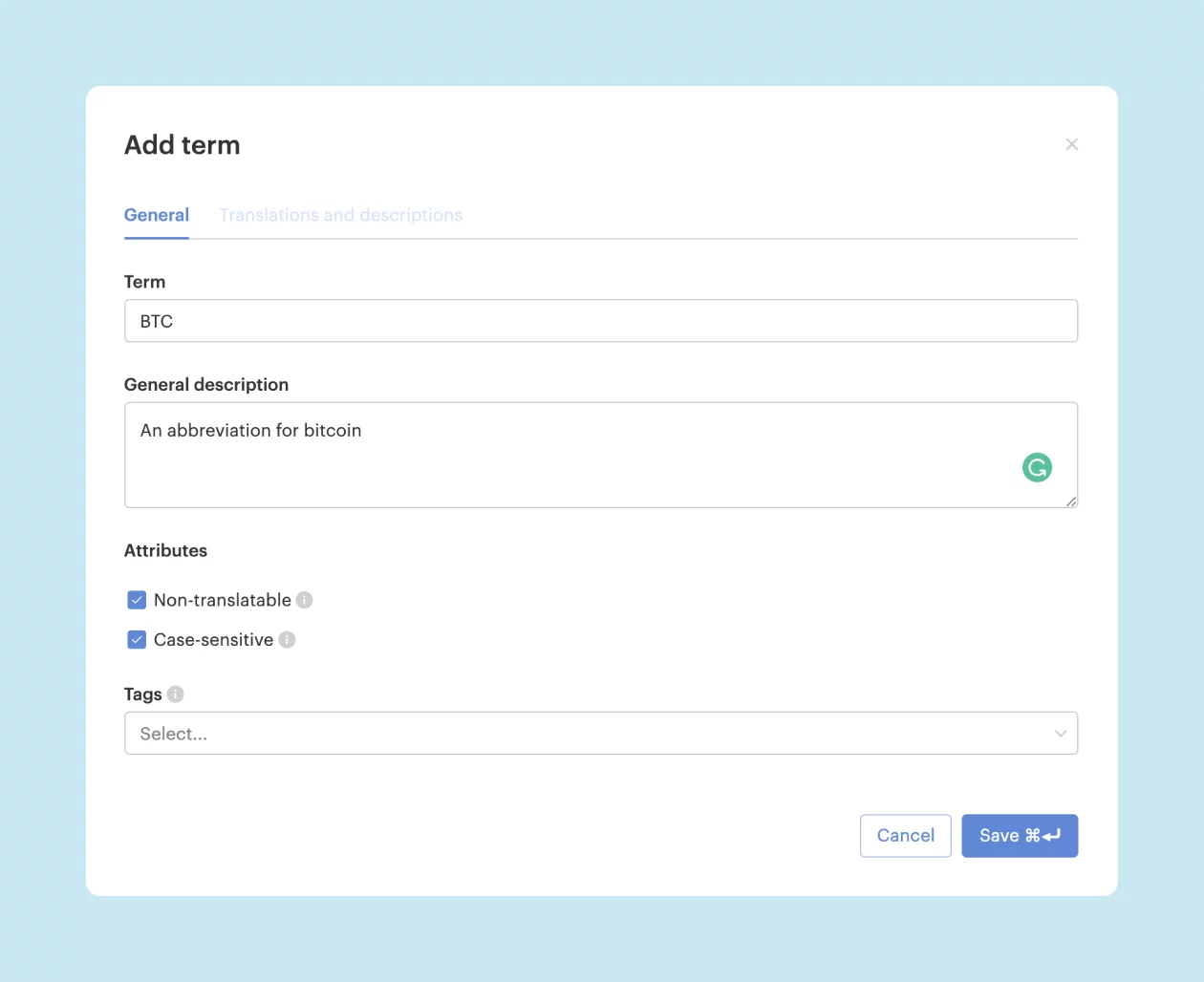
But here is a quick best practice guide for how to build out your glossary. Follow these basic rules and you really can’t go wrong.
Build right, from the start
- Adding sufficient context for the term, and not leaving the description blank, will save you time in the long run.
- Keep your glossary relatively short. The longer it is, the harder it will be to navigate and search through.
- If you are creating a glossary from scratch and aren’t sure where to begin, look at your source text and see which words or phrases come up time and again. Add those to your glossary.
- Make the most of Lokalise’s “extract terms” feature, which adds repeating terms from your project to your glossary.
Collaborate to ensure quality
- Make sure a local expert reviews your newly added glossary terms to ensure accuracy. The quality of your glossary also ensures the quality of your translation.
- Ensure your terminology management is up to date and regularly updated.
- Share your glossary with other projects and team members to maximize usage.
Grow globally with Lokalise
Now you have all our best practice tips on how to make a top-class glossary, you can get started with Lokalise. Sign up for a free trial or book a demo with one of our localization specialists and see how Lokalise can help you grow today.


